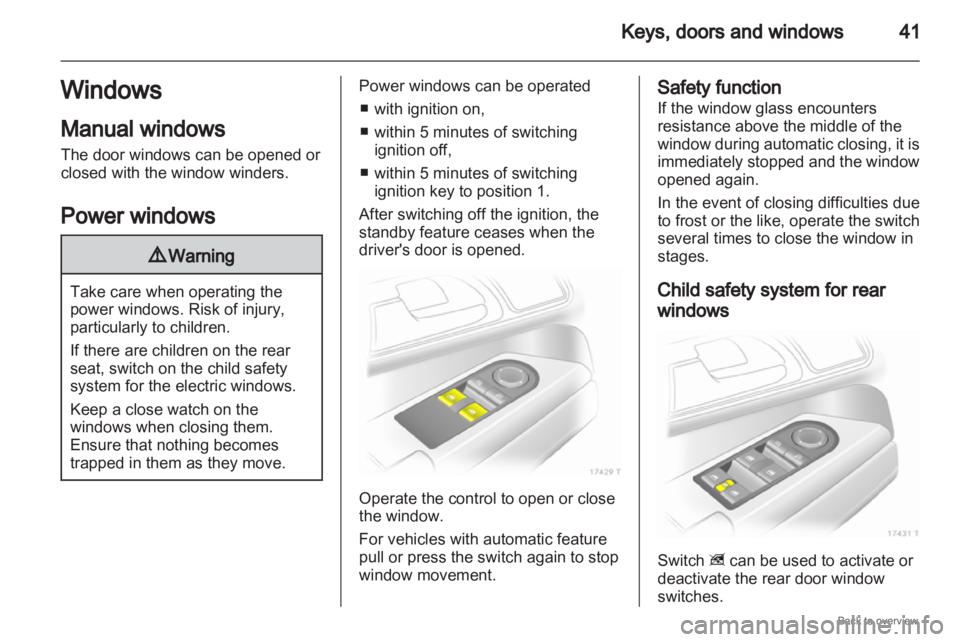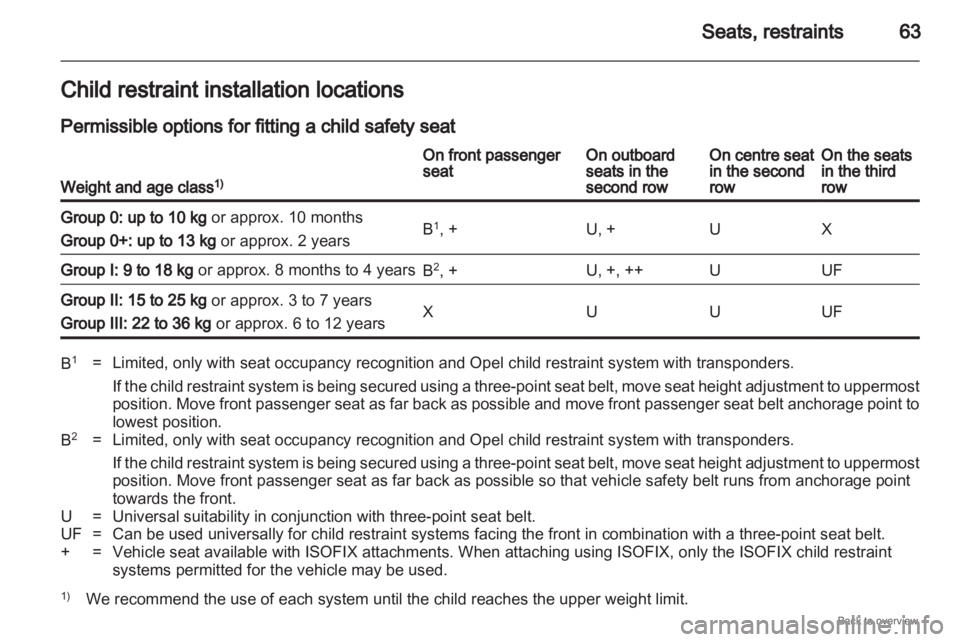Page 35 of 228
Keys, doors and windows
35
Child locks 9
Warning Use the child locks whenever
children are occupying the rear
seats.
Using a key or suitable screwdriver,
turn
button on rear door lock from the
vertical position: door cannot be
opened from inside. Doors
Load compartment
Opening
Press the button underneath the
moulding.
9
Warning Do not drive with the tailgate open
or ajar, e.g. when transporting
bulky objects, since toxic exhaust
gas could enter the vehicle. Note
The installation of certain heavy
accessories onto the tailgate may
affect its ability to remain open.
Closing Use the interior handle.
Do not press the button under the
moulding while closing as this will
unlock it again.
Page 41 of 228

Keys, doors and windows
41
Windows
Manual windows
The door windows can be opened or
closed with the window winders.
Power windows 9
Warning Take care when operating the
power windows. Risk of injury,
particularly to children.
If there are children on the rear
seat, switch on the child safety
system for the electric windows.
Keep a close watch on the
windows when closing them.
Ensure that nothing becomes
trapped in them as they move. Power windows can be operated
■ with ignition on,
■ within 5 minutes of switching ignition off,
■ within 5 minutes of switching ignition key to position 1.
After switching off the ignition, the
standby feature ceases when the
driver's door is opened. Operate the control to open or close
the window.
For vehicles with automatic feature
pull or press the switch again to stop
window movement. Safety function
If the window glass encounters
resistance above the middle of the
window
during automatic closing, it is
immediately stopped and the window
opened again.
In the event of closing difficulties due
to frost or the like, operate the switch
several times to close the window in
stages.
Child safety system for rear
windows Switch z can be used to activate or
deactivate the rear door window
switches.
Page 44 of 228
44
Seats, restraints
Seats, restraints
Head restraints ............................ 44
Front seats ................................... 46
Rear seats ................................... 49
Seat belts ..................................... 54
Airbag system .............................. 57
Child restraints ............................. 62 Head restraints
Position
9
Warning Only drive with the head restraint
set to the proper position.
The middle of the head restraint
should be at eye level. If this is not
possible for extremely tall persons,
set to highest position, and set to
lowest position for small persons. Adjustment
Head restraints with release button
Press the button, adjust height and
engage.
Page 59 of 228
Seats, restraints
59
The front airbag system is triggered in
the event of an accident of a certain
severity in the depicted area. The
ignition must be on.
Seat occupancy recognition 3 61.
Opel child restraint system with
transponders 3 65.The forward movement of the front
seat occupants is retarded, thereby
considerably reducing the risk of
injury to the upper body and head. 9
Warning Optimum protection is only
provided when the seat is in the
proper position
3 46.
Keep the area in which the airbag
inflates clear of obstructions.
Wear the seat belt properly
fastened. Only then the airbag is
able to protect. Side airbag system The side airbag system consists of an
airbag in each front seat backrest.
This can be identified by the word
AIRBAG.
The side airbag system is triggered in
the event of an accident of a certain
severity in the depicted area. The
ignition must be on.
Seat occupancy recognition
3 61.
Opel child restraint system with
transponders 3 65.
Page 61 of 228

Seats, restraints
61
The risk of injury to the head in the
event of a side impact is considerably
reduced.
The curtain airbag system does not
protect the third row of seats. 9
Warning Keep the area in which the airbag
inflates clear of obstructions.
The hooks on the handles in the
roof frame are only suitable for
hanging up light articles of
clothing,
without coat hangers. Do
not keep any items in these
clothes. Seat occupancy
recognition
Identified by a label on the lower
panel
of the front passenger seat and
by control indicator y, which
illuminates for approx. 4 seconds
when the ignition is switched on.
The seat occupancy recognition
system deactivates the passenger
front and side airbag if the front
passenger seat is not occupied or is
fitted with an Opel child restraint
system with transponders. The
curtain airbag system remains
activated. 9
Warning Only Opel child restraint systems
with transponders should be fitted
on
the front passenger seats. Use
of systems without transponders
poses a risk of fatal injury. Control indicator
3 87.
Note
Anyone weighing less than 35 kg
should only travel on the rear seats.
Do not place any heavy objects on
the front passenger seat. Otherwise
the
seat will register as occupied and
the airbag system for the front
passenger seat will not be
deactivated.
Do not use protective covers or seat
cushions on the front passenger
seat.
Page 62 of 228
62
Seats, restraints
Child restraints
Child restraint systems
Follow the usage instructions for the
child restraint system.
Always comply with local or national
regulations. In some countries, the
use of child restraint systems is
forbidden on certain seats.
Selecting the right system
Your child should travel facing
backwards in the vehicle, until as old
as possible. A child has a very weak
cervical spinal column and in the
event of an accident is less likely to
suffer injury in a rearward-facing,
semi-lying position than if seated
upright.
Children
under 12 years or under 150
cm tall should only travel in an
appropriate child safety seat.
When transporting children, use the
child restraint systems suitable for the
child's weight. Note
Do not stick anything on the child
restraint systems and do not cover
them with any other materials.
A child restraint system which has
been subjected to stress in an
accident must be replaced.
Page 63 of 228

Seats, restraints
63
Child restraint installation locations
Permissible options for fitting a child safety seat
Weight and age class 1) On front passenger
seat On outboard
seats in the
second row On centre seat
in the second
row On the seats
in the third
row
Group 0: up to 10 kg or approx. 10 months
Group 0+: up to 13 kg or approx. 2 years
B
1
, + U, + U X
Group I: 9 to 18 kg or approx. 8 months to 4 years
B
2
, + U, +, ++ U UF
Group II: 15 to 25 kg or approx. 3 to 7 years
Group III: 22 to 36 kg or approx. 6 to 12 years
X U U UF
B
1
= Limited, only with seat occupancy recognition and Opel child restraint system with transponders.
If the child restraint system is being secured using a three-point seat belt, move seat height adjustment to uppermost
position. Move front passenger seat as far back as possible and move front passenger seat belt anchorage point to
lowest position.
B 2
= Limited, only with seat occupancy recognition and Opel child restraint system with transponders.
If
the child restraint system is being secured using a three-point seat belt, move seat height adjustment to uppermost
position. Move front passenger seat as far back as possible so that vehicle safety belt runs from anchorage point
towards the front.
U = Universal suitability in conjunction with three-point seat belt.
UF = Can be used universally for child restraint systems facing the front in combination with a three-point seat belt.
+ = Vehicle seat available with ISOFIX attachments. When attaching using ISOFIX, only the ISOFIX child restraint systems permitted for the vehicle may be used.
1) We recommend the use of each system until the child reaches the upper weight limit.
Page 64 of 228
64
Seats, restraints
++ = Vehicle seat available with ISOFIX attachments. When attaching using ISOFIX and Top-tether, universally permitted
ISOFIX child restraint systems may be used.
X = No child restraint system permitted in this weight class.